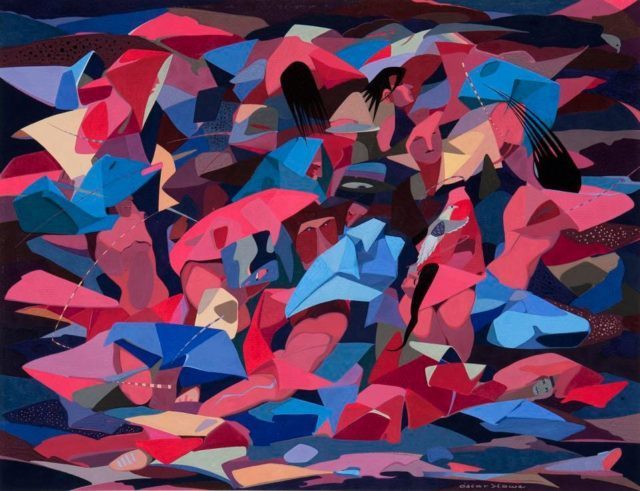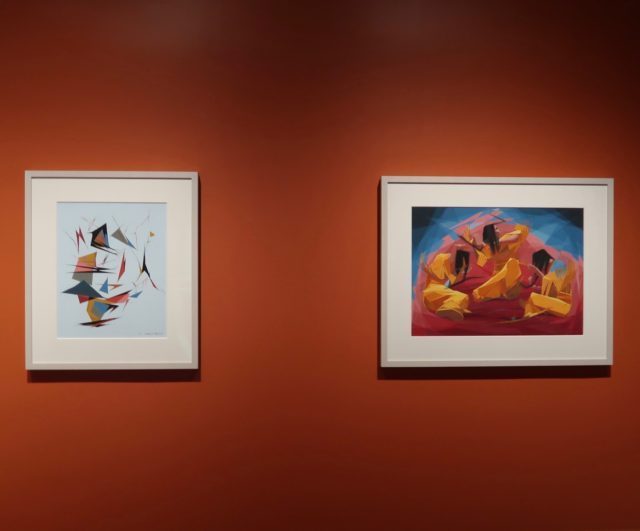
Oscar Howe, Dance of the Heyoka, casein on paper, 1954 (Philbrook Museum of Art, Tulsa, Oklahoma)
DAKOTA MODERN: THE ART OF OSCAR HOWE
National Museum of the American Indian
George Gustave Heye Center, One Bowling Green
Through Sunday, September 11, free
212-514-3700
americanindian.si.edu
In April 1958, after Oscar Howe’s work had been rejected by the Philbrook Art Center, the Yanktonai Dakota artist wrote a letter to curator Jeanne Snodgrass: “Who ever said that my paintings are not in the traditional Indian style has poor knowledge of Indian Art indeed. There is much more to Indian Art than pretty, stylized pictures. There was also power and strength and individualism (emotional and intellectual insight) in the old Indian paintings. Every bit in my paintings is a true studied fact of Indian paintings. Are we to be held back forever with one phase of Indian painting that is the most common way? We are to be herded like a bunch of sheep, with no right for individualism, dictated as the Indian has always been, put on reservations and treated like a child, and only the White Man knows what is best for him. . . . Well, I am not going to stand for it.”
Born in 1915 on the Creek Sioux Reservation in South Dakota, Howe (his tribal name was Mazuha Hokshina) had a distinguished career as an artist, teacher, advocate, and activist. His life and work are explored in the sensational exhibit “Dakota Modern: The Art of Oscar Howe,” which continues at the National Museum of the American Indian through September 11. Howe’s canvases evoke the color and angular graphic style of Jacob Lawrence, but they depict the American Indian experience, particularly his Očhéthi Šakówiŋ (Sioux) culture, instead of that of African Americans. Many of the works, in watercolor, gouache, tempera, and casein on paper, require longer viewing as their subjects emerge from an initially abstract image.
“We are finally at a point in the twenty-first century where we can recognize the impact and complexity of Oscar Howe’s incredible work as both Native American and modern American art,” curator Kathleen Ash-Milby said in a statement. “This project is a long overdue recognition of his contribution to the field that we hope will establish Howe’s place as a twentieth-century modernist.”

Sensational Oscar Howe exhibit continues through September 11 (photo by twi-ny/mdr)
The show follows Howe from his high school years up to his death in 1983 at the age of sixty-eight. The paintings are supplemented with substantial biographical information, including archival film footage, highlighted by a 1960 appearance on This Is Your Life, the television series hosted by Ralph Edwards; Howe collector Vincent Price introduced the artist, who came to regret his participation because it only furthered stereotypes.
In Fleeing a Massacre, an Indian on horseback is caught within a swirling storm of ghosts and the American flag. Wounded Knee Massacre features armed American soldiers on land in the top half, with Indians flailing below in a bloody pit. At first, Fighting Bucks looks like a kind of acid trip until the antlers and bodies of two deer become evident. Dance of the Heyoka comes at you in a barrage of complex geometric shapes and bold colors.
“Dakota Modern: The Art of Oscar Howe” is an exceptional, revelatory show, arriving right on time as a reckoning is underway in the art world, reexamining work done by underrepresented and misrepresented creators. The rediscovery of Howe is nothing less than thrilling; the exhibition is accompanied by a deluxe catalog with essays by Janet Catherine Berlo, Christina Burke, Philip J. Deloria, Erika Doss, Emil Her Many Horses, John Lukavic, Inge Dawn Howe Maresh, Anya Montiel, Denise Neil, and Joyce Szabo that shed new light on this extraordinary artist.